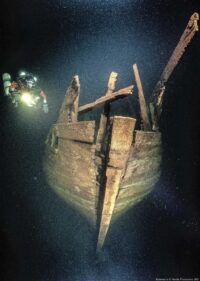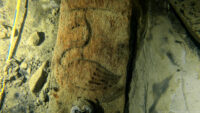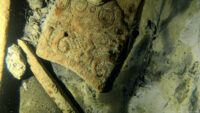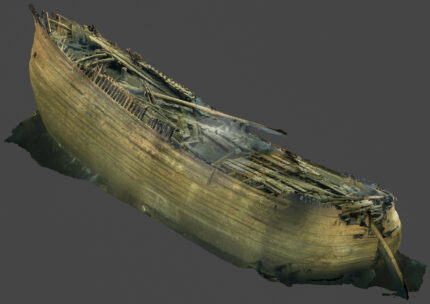The 17th century fluyt discovered in the Gulf of Finland last summer has been identified as the Swan, built in 1636. It was a carved timber transom, preserved in the cold and shipworm-free waters of the Eastern Baltic that solved the mystery. This is the first time a 17th century has been identified from markings on its transom.
 The merchant vessel was found on the seabed 280 feet beneath the surface by divers from the Finnish organization Badewanne which documents and maps the many shipwrecks from the World Wars that litter the Gulf of Finland. The ship had been damaged by fishing trawlers. Its three masts had been pulled out and some of the deck timbers. The wooden transom, once mounted vertically above the stern post and tiller, had broken off and fallen face down onto the seabed under the stern.
The merchant vessel was found on the seabed 280 feet beneath the surface by divers from the Finnish organization Badewanne which documents and maps the many shipwrecks from the World Wars that litter the Gulf of Finland. The ship had been damaged by fishing trawlers. Its three masts had been pulled out and some of the deck timbers. The wooden transom, once mounted vertically above the stern post and tiller, had broken off and fallen face down onto the seabed under the stern.
Fluyt ships typically carried a transom plate that was engraved with key data about the ship — the name in figure form, the year of construction, often the coat of arms of the vessel’s home port — so it was important to get a look at the face of the transom. With a 20-minute limit on dives and just a few days to do them in, Badewanne divers were unable to turn the heavy timber over last year.
 They returned to the find site this summer for a two-week diving camp to explore the wreck while filming a documentary about it, and this time they were able to turn the transom over, revealing the engraved image of a swan and the year 1636. At the time carving on the transom was often a visual depiction of the name of the ship to make it recognizable without requiring literacy. The large swan standing in profile above the 1636 construction date was not a random decoration, therefore, but rather the ship’s name. The corroded circle is likely the attachment point of a lantern, now lost.
They returned to the find site this summer for a two-week diving camp to explore the wreck while filming a documentary about it, and this time they were able to turn the transom over, revealing the engraved image of a swan and the year 1636. At the time carving on the transom was often a visual depiction of the name of the ship to make it recognizable without requiring literacy. The large swan standing in profile above the 1636 construction date was not a random decoration, therefore, but rather the ship’s name. The corroded circle is likely the attachment point of a lantern, now lost.
 The diving team took detailed measurements and photographs of the wreck. The images were stitched together to create a detailed photogrammetric 3D model of the wreck. Extrapolating from the model, researchers were able to calculate the original dimensions of the ship before its sinking. The team hopes to be able to find documentary records of the fluyt now that they know the name, year and measurements.
The diving team took detailed measurements and photographs of the wreck. The images were stitched together to create a detailed photogrammetric 3D model of the wreck. Extrapolating from the model, researchers were able to calculate the original dimensions of the ship before its sinking. The team hopes to be able to find documentary records of the fluyt now that they know the name, year and measurements.
According to Niklas Eriksson, a maritime archaeologist at Stockholm University specialising in fluits, the ships were identified at the time on the basis of the information engraved on the transom. Pieces of the transom have been found in marine archaeological research in the past, but this is the first time, according to Eriksson, that all transom information is available.
“More detailed investigations are likely to reveal the coat of arms that will show the ship’s home port,” Eriksson said.
The real reason for the sinking of the ship may never be clear, Polkko said, noting that there are a couple of manual water pumps on the deck of the wreck. This suggests the crew may not have had time to pump water out fast enough.
“At that time, grain was transported in the hold of the ships. If a lot of water gets in there, it could block the pumps,” Polkko explained.
